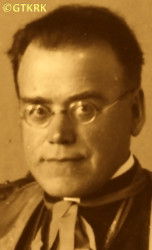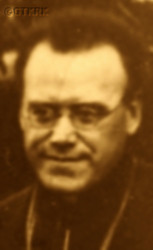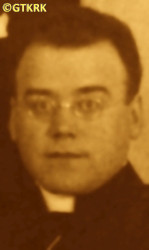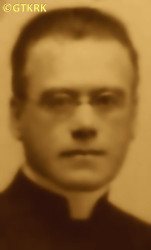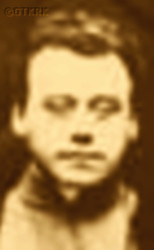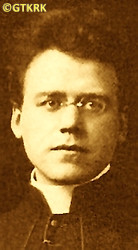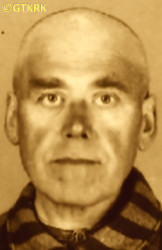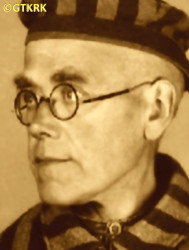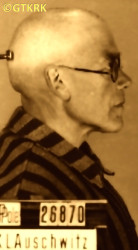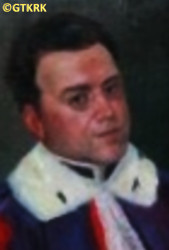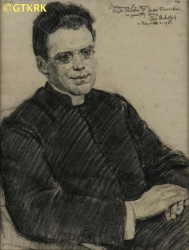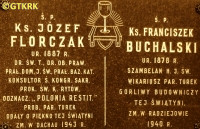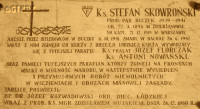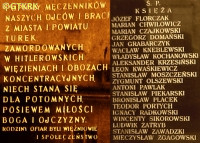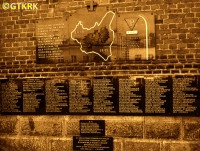Roman Catholic
St Sigismund parish
05-507 Słomczyn
85 Wiślana Str.
Konstancin deanery
Warsaw archdiocese, Poland
full list:
displayClick to display full list

searchClick to search full list by categories
wyświetlKliknij by wyświetlić pełną listę po polsku

szukajKliknij by przeszukać listę wg kategorii po polsku

Martyrology of the clergy — Poland
XX century (1914 – 1989)
personal data
surname
FLORCZAK
forename(s)
Joseph (pl. Józef)
function
diocesan priest
creed
Latin (Roman Catholic) Church RCmore on
en.wikipedia.org
[access: 2014.09.21]
diocese / province
Włocławek diocesemore on
en.wikipedia.org
[access: 2013.05.19]
Włocławek i.e. Kalisz diocesemore on
pl.wikipedia.org
[access: 2019.10.13]
academic distinctions
Doctor of Law
Doctor of Sacred Theology
honorary titles
pontifical prelatemore on
en.wikipedia.org
[access: 2014.11.14]
(1929)
Prelate‐archdeacon (Lat. praelati‐archidiaconus)more on
en.wikipedia.org
[access: 2014.11.14]
(26.09.1930 – , Assumption of the Blessed Virgin Mary RC cathedral church, Włocławektoday: Włocławek city pov., Kuyavia‐Pomerania voiv., Poland
more on
en.wikipedia.org
[access: 2021.12.18])
honorary canonmore on
en.wikipedia.org
[access: 2014.11.14]
(26.09.1930 – , Assumption of the Blessed Virgin Mary RC cathedral church, Włocławektoday: Włocławek city pov., Kuyavia‐Pomerania voiv., Poland
more on
en.wikipedia.org
[access: 2021.12.18], Immaculate Conception of the Blessed Virgin Mary RC cathedral church, Siedlcetoday: Siedlce city pov., Masovia voiv., Poland
more on
en.wikipedia.org
[access: 2021.08.20])
Minor Canonmore on
en.wikipedia.org
[access: 2014.11.14]
(03.01.1926 – , Assumption of the Blessed Virgin Mary RC collegiate church, Kalisztoday: Kalisz city pov., Greater Poland voiv., Poland
more on
en.wikipedia.org
[access: 2020.12.16])
Doctor Honoris Causa
(16.05.1922, Paduatoday: Padua prov., Veneto reg., Italy
more on
en.wikipedia.org
[access: 2022.07.06]; Universitas Studii Paduani (Eng. University of Padua))
„Polonia Restituta” Cross — 3rd Class, Commander'smore on
en.wikipedia.org
[access: 2019.04.16]
(10.11.1928)
Gold „Cross of Merit”more on
en.wikipedia.org
[access: 2019.04.16]
(24.08.1938)
Gold „Cross of Merit”more on
en.wikipedia.org
[access: 2019.04.16]
(11.11.1935)
date and place
of death
20.04.1943

KL Dachauconcentration camp
today: Dachau, Upper Bavaria reg., Bavaria state, Germany
more on
en.wikipedia.org
[access: 2016.05.30]
details of death
After German and Russian invasion of Poland in 09.1939 and start of the World War II, when German occupation started — after capitulation the Polish capital — was in Warsaw.
Arrested by the Germans on 03.10.1939 and held as a hostage, prob. as prevention before triumphal arrival of German socialist leader, Adolf Hitler, in captured Warsaw, together with c. 250 Catholic priests and clerics in Pawiak prison.
Released on c. 11‐15.10.1939.
Managed to return to his Turek parish prior of setting up German‐run Germ. Generalgouvernement (Eng. General Governorate) and closing its borders.
In c. 11.1939 arrested by the Germans in Poznań.
„Beaten until he was covered with blood”.
Released for a short time and rearrested? Again released.
Arrested again in 09.1941 by agents of the German secret political police Gestapo from Łódź. It is known that was in prison — prob. in Łódź — on 21.11.1941.
According to some sources for the last time was arrested in early 1942, which would mean was released earlier.
Prob. on 17.03.1942 transported to KL Auschwitz concentration camp, and from there on 03‐05.06.1942 to KL Dachau concentration camp where perished.
According to the death certificate, prepared in KL Dachau, the „honest” otherwise German „medical doctors” and formalists — and at the same time, unrivaled fairy tale spinners — noted that the cause of death was Germ. „Versagen von Herz und Kreislauf, bei Phlegmone am rechten Knie” (Eng. „Heart and circulatory failure, due to phlegmon of the right knee”).
prisoner camp's numbers
30277Click to display source page (KL DachauClick to display the description), 26870Click to display source page (KL AuschwitzClick to display the description)
cause of death
extermination: exhaustion and starvation
perpetrators
Germans
sites and events
KL DachauClick to display the description, KL AuschwitzClick to display the description, Regierungsbezirk KattowitzClick to display the description, KL PosenClick to display the description, SPL PosenClick to display the description, Reichsgau WarthelandClick to display the description, PawiakClick to display the description, «Intelligenzaktion»Click to display the description, Collective responsibility („Hostages”)Click to display the description, GeneralgouvernementClick to display the description, Ribbentrop‐MolotovClick to display the description, Pius XI's encyclicalsClick to display the description
date and place
of birth
25.09.1887Birth certification on:
metryki.genealodzy.pl
[access: 2025.03.27]

Luciejówtoday: Buczek gm., Łask pov., Łódź voiv., Poland
more on
en.wikipedia.org
[access: 2022.01.28]
parents
FLORCZAK Joseph
🞲 ?, ? — 🕆 ?, ?

TARKA Antonina
🞲 ?, ? — 🕆 ?, ?
baptism
26.09.1887Birth certification on:
metryki.genealodzy.pl
[access: 2025.03.27]

Buczektoday: Buczek gm., Łask pov., Łódź voiv., Poland
more on
en.wikipedia.org
[access: 2020.12.16]
St John the Baptist RC church
presbyter (holy orders)
ordination
07.08.1910

positions held
1936 – 1941
dean — Turektoday: Turek gm., Turek pov., Greater Poland voiv., Poland
more on
en.wikipedia.org
[access: 2020.12.11] RC deanery
1931 – 1941
parish priest — Turektoday: Turek gm., Turek pov., Greater Poland voiv., Poland
more on
en.wikipedia.org
[access: 2020.12.11] ⋄ Sacred Heart of Jesus RC parish ⋄ Turektoday: Turek gm., Turek pov., Greater Poland voiv., Poland
more on
en.wikipedia.org
[access: 2020.12.11] RC deanery
1930 – 1941
Prelate‐archdeacon (Lat. praelati‐archidiaconus) — Włocławektoday: Włocławek city pov., Kuyavia‐Pomerania voiv., Poland
more on
en.wikipedia.org
[access: 2021.12.18] ⋄ Cathedral Chapter ⋄ Assumption of the Blessed Virgin Mary RC cathedral church
1920 – 1931
rector — Rometoday: Rome prov., Lazio reg., Italy
more on
en.wikipedia.org
[access: 2021.12.18] ⋄ St Stanislav the Bishop and Martyr RC church
1926 – 1930
Minor Canon — Kalisztoday: Kalisz city pov., Greater Poland voiv., Poland
more on
en.wikipedia.org
[access: 2020.12.16] ⋄ Collegiate Chapter ⋄ Assumption of the Blessed Virgin Mary RC collegiate church
1920 – 1929
treasury officer / procurator — Rometoday: Rome prov., Lazio reg., Italy
more on
en.wikipedia.org
[access: 2021.12.18] ⋄ łac. Congregatio pro Sacri Ritibus (Eng. Congregation of Sacred Rites), Roman Curia
1920 – 1929
consultor — Rometoday: Rome prov., Lazio reg., Italy
more on
en.wikipedia.org
[access: 2021.12.18] ⋄ Lat. Sacra Congregatio de Disciplina Sacramentorum (Eng. Sacred Congregation for the Discipline of the Sacraments), Roman Curia
1920 – 1929
auditor — Rometoday: Rome prov., Lazio reg., Italy
more on
en.wikipedia.org
[access: 2021.12.18] ⋄ Lat. „Tribunal Rotae Romanae”, Roman Curia
1920 – 1927
employee — Rometoday: Rome prov., Lazio reg., Italy
more on
en.wikipedia.org
[access: 2021.12.18] ⋄ Lat. Sacra Congregatio de Propaganda Fide (Eng. Sacred Congregation for the Propagation of the Faith), Roman Curia
16.05.1922
Doctor Honoris Causa — Paduatoday: Padua prov., Veneto reg., Italy
more on
en.wikipedia.org
[access: 2022.07.06] ⋄ Universitas Studii Paduani (Eng. University of Padua)
1919 – 1920
dean — Lublintoday: Lublin city pov., Lublin voiv., Poland
more on
en.wikipedia.org
[access: 2021.08.20] ⋄ Department of Canon Law and Moral Sciences, Catholic University of Lublin KUL [i.e. Catholic University of Lublin KUL (since 1928) / clandestine Catholic University of Lublin KUL (1939‐1944) / University of Lublin (1918‐1928)]
1918 – 1922
professor — Lublintoday: Lublin city pov., Lublin voiv., Poland
more on
en.wikipedia.org
[access: 2021.08.20] ⋄ Department of Canon Law and Moral Sciences, Catholic University of Lublin KUL [i.e. Catholic University of Lublin KUL (since 1928) / clandestine Catholic University of Lublin KUL (1939‐1944) / University of Lublin (1918‐1928)]
1915 – 1918
professor — Sankt Petersburgtoday: Saint Petersburg city, Russia
more on
en.wikipedia.org
[access: 2020.07.31] ⋄ Imperial Roman Catholic Spiritual Academy (1842‐1918)
1913 – 1914
PhD student — Rometoday: Rome prov., Lazio reg., Italy
more on
en.wikipedia.org
[access: 2021.12.18] ⋄ law, „Angelicum” [i.e. Lat. Pontificia Universitas Studiorum a Sancto Thoma Aquinate in Urbe (Eng. Pontifical University of St Thomas Aquinas) (today) / Lat. Pontificium Institutum Internationale (Eng. Pontifical International Institute) (1926‐1963) / Lat. Pontificium Collegium (Eng. Pontifical College) (1906‐1926) / Lat. Collegium (Eng. College) (until 1906)] — PhD thesis Lat. „De caelibatu cleri Poloniae” (Eng. „On the celibacy of the Polish clergy”), public defense on 03.07.1919
1910 – 1913
student — Sankt Petersburgtoday: Saint Petersburg city, Russia
more on
en.wikipedia.org
[access: 2020.07.31] ⋄ philosophy and theology, Imperial Roman Catholic Spiritual Academy (1842‐1918) — postgraduate specialised studies crowned with a Sacred Theology Master's degree
1903 – 1909
student — Włocławektoday: Włocławek city pov., Kuyavia‐Pomerania voiv., Poland
more on
en.wikipedia.org
[access: 2021.12.18] ⋄ philosophy and theology, Theological Seminary
sites and events
descriptions
KL Dachau: KL Dachau in German Bavaria, set up in 1933, became the main German Germ. Konzentrationslager (Eng. concentration camp) KL for Catholic priests and religious during World War II: On c. 09.11.1940, Reichsführer‐SS Heinrich Himmler, head of the SS, Gestapo and German police, as a result of the Vatican's intervention, decided to transfer all clergymen detained in various concentration camps to KL Dachau camp. The first major transports took place on 08.12.1940. In KL Dachau Germans held approx. 3,000 priests, including 1,800 Poles. The priests were forced to slave labor in the Germ. „Die Plantage” — the largest herb garden in Europe, managed by the genocidal SS, consisting of many greenhouses, laboratory buildings and arable land, where experiments with new natural medicines were conducted — for many hours, without breaks, without protective clothing, no food. They slaved in construction, e.g. of camp's crematorium. In the barracks ruled hunger, freezing cold in the winter and suffocating heat during the summer, especially acute in 1941‐1942. Prisoners suffered from bouts of illnesses, including tuberculosis. Many were victims of murderous „medical experiments” — in 11.1942 c. 20 were given phlegmon injections; in 07.1942 to 05.1944 c. 120 were used by for malaria experiments. More than 750 Polish clerics where murdered by the Germans, some brought to TA Hartheim euthanasia centre set up in Schloss Hartheim in Austria and murdered in gas chambers. At its peak KL Dachau concentration camps’ system had nearly 100 slave labour sub‐camps located throughout southern Germany and Austria. There were c. 32,000 documented deaths at the camp, and thousands perished without a trace. C. 10,000 of the 30,000 inmates were found sick at the time of liberation, on 29.04.1945, by the USA troops… (more on: www.kz-gedenkstaette-dachau.deClick to attempt to display webpage
[access: 2013.08.10], en.wikipedia.orgClick to attempt to display webpage
[access: 2016.05.30])
KL Auschwitz: German Germ. Konzentrationslager (Eng. concentration camp) KL and Germ. Vernichtungslager (Eng. extermination camp) VL Auschwitz was set up by Germans around 27.01.1940 n. Oświęcim, on the German territory (initially in Germ. Provinz Schlesien — Silesia Province; and from 1941 Germ. Provinz Oberschlesien — Upper Silesia Province). Initially mainly Poles were interned. From 1942 it became the centre for holocaust of European Jews. Part of the KL Auschwitz concentration camps’ complex was Germ. Vernichtungslager (Eng. extermination camp) VL Auschwitz II Birkenau, located not far away from the main camp. There Germans murdered likely in excess of million people, mainly Jews, in gas chambers. In KL Auschwitz alone, the Germans murdered c. 30,000 prisoners by lethal injection. Until 1941, people were killed by intravenous injections of concentrated hydrogen peroxide, ether, hydrogen peroxide, or gasoline. Later, an intracardiac injection was used — with a needle about 10 cm long — of 10‐15 ml of a 30% solution of phenol C6H5OH (acquired from the German concern IG Farben, or more precisely from its subsidiary Bayer, and still used by Bayer AG, among others, for the production of aspirin), which killed within 15 seconds. Altogether In excess of 400 priests and religious went through the KL Auschwitz, c. 40% of which were murdered (mainly Poles). (more on: en.auschwitz.org.plClick to attempt to display webpage
[access: 2012.11.23], www.meczennicy.pelplin.plClick to attempt to display webpage
[access: 2013.07.06])
Regierungsbezirk Kattowitz: After the Polish defeat in the 09.1939 campaign, which was the result of the Ribbentrop‐Molotov Pact and constituted the first stage of World War II, and the beginning of German occupation in part of Poland (in the other, eastern part of Poland, the Russian occupation began), the Germans divided the occupied Polish territory into five main regions (and a few smaller). The largest one was transformed into Germ. Generalgouvernement (Eng. General Governorate), intended exclusively for Poles and Jews and constituting part of the so‐called Germ. Großdeutschland (Eng. Greater Germany). From two separate new provinces were created. The two remaining were incorporated into existing German provinces. One of those was Polish Upper Silesia, which on 08.09.1939, by decree of the German leader Adolf Hitler (formally came into force on 26.10.1939), was incorporated into Germany as the Germ. Regierungsbezirk Kattowitz (Eng. Katowice Regency) and became part of the Germ. Provinz Schlesien (Eng. Province of Silesia) based in Wrocław. On 01.04.1940, the Germ. Regierungsbezirk Kattowitz was enlarged by several pre‐war German counties, and on 18.01.1941, a new German province was created, the Germ. Provinz Oberschlesien (Eng. Province of Upper Silesia), which, apart from the Germ. Regierungsbezirk Kattowitz, also included the Opole region. From 26.10.1939, when the regency was established, the law of the German state was in force there, the same as in Berlin. The main axis of the policy of the new regency, the territory of which the Germans recognized as the Germ. „Ursprünglich Deutsche” (Eng. „natively German”), despite the fact only 6% of its pre–war Polish part were Germans, was Germ. „Entpolonisierung” (Eng. „Depolonisation”), i.e. forced Germanization. The main mechanism was the introduction of the Germ. Deutsche Volksliste DVL, a German nationality list that was supposed to specify the national affiliation of the inhabitants of the region. The largest group marked in the compulsory registrations was Group 3, people who identified themselves as „Silesians” (in 1943 about 41%), and people remaining outside the DVL (about 36%). The latter group was intended to be deported to the Germ. Generalgouvernement (which did not happen en masse because German industry needed slave labor). Group 3, considered by the Germans as capable of Germanization, was subject to certain legal restrictions, and was subject to, among others, to conscription into the German Wehrmacht army. Children could only learn in German. A policy of terror was pursued against the Polish population. There was a special police court, controlled by the Germ. Geheime Staatspolizei (Eng. Secret State Police), i.e. the Gestapo, before which c. 4,000‐5,000 people were detained. For the years 1942‐1945 over 2,000 of them were verified, of which 1,890 were sentenced to death, including 286 in public executions. Thousands of people were murdered during the so‐called «Intelligenzaktion Schlesien», including 300‐650 Polish teachers and c. 61 Polish Catholic priests. The regency hosted a German concentration and extermination camp KL Auschwitz, where the Germans imprisoned c. 1,100,000 Jews (murdering c.1,000,000, i.e. c. 90% of them) and c. 140,000 Poles (murdering c. 70,000, i.e. c. 50% of them). After the end of hostilities of World War II, the overseer of this province, the Germ. Reichsstatthalter (Eng. Reich Governor) and the Germ. Gauleiter (Eng. district head) of the German National Socialist Party, Fritz Brecht, committed suicide. (more on: en.wikipedia.orgClick to attempt to display webpage
[access: 2024.06.24])
KL Posen: German Posen — Fort VII — camp founded in c. 10.10.1939 in Poznań till mid of 11.1939 operated formally as Germ. Konzentrationslager (Eng. concentration camp) KL Posen, and this term is used throughout the White Book, also later periods. It was first such a concentration camp set up by the Germans on Polish territory — in case of Greater Poland (Wielkopolska) directly incorporated into German Reich. In 10.1939 in KL Posen for the first time Germans used gas to murder civilian population, in particular patients of local psychiatric hospitals. From 11.1939 the camp operated as German political police Gestapo prison and transit camp (Germ. Übergangslager), prior to sending off to concentration camps, such as KL Dachau or KL Auschwitz. In 28.05.1941 the camp was rebranded as police jail and slave labour corrective camp (Germ. Arbeitserziehungslager). At its peak up to 7‐9 executions were carried in the camp per day, there were mass hangings of the prisoners and some of them were led out to be murdered elsewhere, outside of the camp. Altogether in KL Posen Germans exterminated approx. 20,000 inhabitants of Greater Poland (Wielkopolska) region, including many representatives of Polish intelligentsia, patients and staff of psychiatric hospitals and dozen or so Polish priests. Hundreds of priests were held there temporarily prior to transport to other concentration camps, mainly KL Dachau. From 03.1943 the camp had been transformed into an industrial complex (from 25.04.1944 — Telefunken factory manufacturing radios for submarines and aircrafts). (more on: www.wmn.poznan.plClick to attempt to display webpage
[access: 2019.02.02], en.wikipedia.orgClick to attempt to display webpage
[access: 2013.12.27])
SPL Posen: Germ. Staatpolizeileitstelle Posen (Eng. Poznań State Police Command Centre), founded on 07.11.1939 — in the Soldier's House at 1 Niezłomnych Str. — by the Germ. Geheime Staatspolizei (Eng. Secret State Police), i.e. Gestapo, after taking over the building from the Germ. Einsatzgruppe VI der Sicherheitspolizei und des SD (Eng. Task Group VI of the Security Police and SD), which had its HQ there from 12.09.1939, the day the Germans captured Poznań. The Centre performed a superior function to Gestapo offices in the entire Germ. Reichsgau Wartheland (Eng. Wartheland Reich District). It housed the Germ. Hausgefängnis (Eng. house arrest). In the basement, on the bare floor, 40‐120 prisoners were held in shackles. In the rooms on the floors, long interrogations were conducted, during which confessions of guilt and signing of protocols were forced by torture. The Germ. Polizeistandgericht (Eng. police summary court) operated there as well, with unlimited competences — the sentences issued were not subject to appeal. Those convicted of „lesser crimes” were transported to the KL Posen concentration camp, and then to other concentration camps. Those sentenced to death were taken to the UH Posen prison on Młyńska Str., where the sentences were carried out. On 20.01.1945, in the face of the Russian offensive, the Germans began the evacuation of the Centre, and on 02.02.1945 they partially blew up the building. (more on: pl.wikipedia.orgClick to attempt to display webpage
[access: 2015.09.30])
Reichsgau Wartheland: After the Polish defeat in the 09.1939 campaign, which was the result of the Ribbentrop‐Molotov Pact and constituted the first stage of World War II, and the beginning of German occupation in part of Poland (in the other, eastern part of Poland, the Russian occupation began), the Germans divided the occupied Polish territory into five main regions (and a few smaller). The largest one was transformed into Germ. Generalgouvernement (Eng. General Governorate), intended exclusively for Poles and Jews and constituting part of the so‐called Germ. Großdeutschland (Eng. Greater Germany). Two were added to existing German provinces. From two other separate new provinces were created. Greater Poland region was one of them, incorporated into Germany on 08.10.1939, by decree of the German leader Adolf Hitler (formally came into force on 26.10.1939), and on 24.01.1940 transformed into the Germ. Reichsgau Wartheland (Eng. Wartheland Reich Province), in which the law of the German state was to apply. The main axis of the policy of the new province, the territory of which the Germans recognized as the Germ. „Ursprünglich Deutsche” (Eng. „natively German”), despite the fact that 90% of its inhabitants were Poles, was Germ. „Entpolonisierung” (Eng. „Depolonisation”), i.e. forced Germanization. C. 100,000 Poles were murdered as part of the Germ. „Intelligenzaktion”, i.e. extermination of Polish intelligentsia and ruling classes. C. 630,000 were forcibly resettled to the Germ. Generalgouvernement, and their place taken by the Germans brought from other areas occupied by Germany (e.g. the Baltic countries, Bessarabia, Bukovina, etc.). Poles were forced to sign the German nationality list, the Germ. Deutsche Volksliste DVL. As part of the policy of „Ohne Gott, ohne Religion, ohne Priesters und Sakramenten” (Eng. „No God, no religion, no priest or sacrament”) most Catholic priests were arrested and sent to concentration camps. All schools teaching in Polish, Polish libraries, theaters and museums were closed. Polish landed estates confiscated. To further reduce the number of the Polish population, Poles were sent to forced labor deep inside Germany, and the legal age of marriage for Poles was increased (25 for women, 28 for men). The German state office, Germ. Rasse‐ und Siedlungshauptamt (Eng. Main Office of Race and Settlement) RuSHA, under the majesty of German law, abducted several thousand children who met specific racial criteria from Polish families and subjected them to forced Germanization, handing them over to German families. After the end of hostilities of World War II, the overseer of this province, the Germ. Reichsstatthalter (Eng. Reich Governor) and the Germ. Gauleiter (Eng. district head) of the German National Socialist Party, Arthur Karl Greiser, was executed. (more on: en.wikipedia.orgClick to attempt to display webpage
[access: 2024.06.21])
Pawiak: Investigative prison in Warsaw, built by the Russian occupiers of Poland in 1830‐1835. During the Poland partition's period, a Russian investigative prison, both criminal and political. During World War II and the German occupation, the largest German prison in the Germ. Generalgouvernement (Eng. General Governorate). Initially, it was subordinate to the Justice Department of the General Governorate, and from 03.1940 Germ. Sicherheitspolizei und des Sicherheitsdienst (Eng. Security Police and Security Service) of the Warsaw District — in particular the German Secret Political Police Gestapo. c. 3,000 prisoners were kept in Pawiak permanently, of which about 2,200 in the men's unit and c. 800 in the women's unit (the so‐called Serbia) — with a „capacity” of c. 1,000 prisoners. In total, in the years 1939‐1944, c. 100,000 Poles passed through the prison, of which c. 37,000 were murdered in executions — from 10.1943 Pawiak prisoners were murdered in open executions on the streets of Warsaw (sometimes several times a day) — during interrogations, in cells or in a prison „hospital”, and c. 60,000 were taken in 95 transports to concentration camps (mainly KL Auischwitz), other places of isolation or to forced labor. The prison Germans demolished during the Warsaw Uprising in 08‐10.1944. (more on: en.wikipedia.orgClick to attempt to display webpage
[access: 2022.08.17])
«Intelligenzaktion»: German: «Intelligenzaktion» (English: „Intelligence Action”) — a German program of extermination of the Polish elite, mainly the intelligentsia and leadership layers, carried out from the beginning of the occupation in w 09.1939 to 04.1940, mainly in territories directly annexed to Germany, but also in the so‐called Germ. Generalgouvernement (Eng. General Governorate), where it was called «AB‐aktion». In the first phase, immediately after the beginning of the German occupation, during military operations carried out by the Germ. Wehrmacht (Eng. Armed Forces) and the genocidal units of the Germ. Einsatzgruppen (Eng. Operational Groups) of the Germ. Sicherheitspolizei (Eng. Security Police), i.e. SiPo, and Germ. Sicherheitsdienst des Reichsführers SS (Eng. Security Service of the Reichsführer SS), i.e. SD, organized by the Germ. Reichssicherheitshauptamt (Eng. Reich Main Security Office), i.e. RSHA, which followed the troops, carried out under the Germ. Unternehmen „Tannenberg” (Eng. Operation „Tannenberg”) — based on the so‐called Germ. Sonderfahndungsliste (Eng. Special Wanted Lists), i.e. proscription lists of Poles considered particularly dangerous to the Third Reich, prepared by the Zentralstelle II/P (Polen) unit of the German RSHA. Later, implemented by the German civilian occupation authorities and the genocidal unit of the Germ. Volksdeutscher Selbstschutz (Eng. Ethnic Germans Self‐Defense), whose members were Germ. Volksdeutsche (Eng. Ethnic Germans), i.e. representatives of the German minority in Poland. According to various sources, these lists, at the beginning of 09.1939, could have contained the details of 61,000—88,000 „dangerous” Poles — although these figures cannot be confirmed. In total, during this genocide, c. 50,000 teachers, Catholic priests, representatives of the landed gentry, freelancers, social and political activists, and retired military personnel were systematically and methodically murdered. Another 50,000 were sent to concentration camps, where only a negligible percentage survived. (more on: en.wikipedia.orgClick to attempt to display webpage
[access: 2014.10.04])
Collective responsibility („Hostages”): A criminal practice implemented by the Germans in the occupied territories of Poland, applied from the very first day of World War II. At its core was an appointment and public announcement of a list of names of selected people whose lives depended on absolute compliance with German orders. Any violation of these ordinances, by any person, regardless of the circumstances, resulted in the murder of the designated „hostages”. In the first days of the war and occupation, it was used i.a. by the German Wehrmacht army to prevent acts of continuation of the defense by the Poles. Later, especially in the German‐run General Governorate, it was part of the official policy of the occupation authorities — collective responsibility for any acts of resistance to the occupier's practices. For the life of one German, even if death was due to customary reasons, the Germans carried out executions from a dozen to even a hundred Poles previously designated as „hostages”.
Generalgouvernement: After the Polish defeat in the 09.1939 campaign, which was the result of the Ribbentrop‐Molotov Pact and constituted the first stage of World War II, and the beginning of German occupation in part of Poland (in the other, eastern part of Poland, the Russian occupation began), the Germans divided the occupied Polish territory into five main regions. In two of them new German provinces were created, two other were incorporated into other provinces. However, the fifth part was treated separately, and in a political sense it was supposed to recreate the German idea from 1915 (during World War I, after the defeat of the Russians in the Battle of Gorlice in 05.1915) of creating a Polish enclave within Germany. Illegal in the sense of international law, i.e. Hague Convention, and public law, managed by the Germans according to separate laws — especially established for the Polish Germ. Untermenschen (Eng. subhumans) — till the Russian offensive in 1945 it constituted part of the Germ. Großdeutschland (Eng. Greater Germany). Till 31.07.1940 formally called Germ. Generalgouvernement für die besetzten polnischen Gebiete (Eng. General Government for the occupied Polish lands) — later simply Germ. Generalgouvernement (Eng. General Governorate), as in the years 1915‐1918. From 07.1941, i.e. after the German attack on 22.06.1941 against the erstwhile ally, the Russians, it also included the Galicia district, i.e. the Polish pre‐war south‐eastern voivodeships. A special criminal law was enacted and applied to Poles and Jews, allowing for the arbitrary administration of the death penalty regardless of the age of the „perpetrator”, and sanctioning the use of collective responsibility. After the end of the military conflict of the World War UU, the government of the Germ. Generalgouvernement was recognized as a criminal organization, and its leader, governor Hans Frank, guilty of war crimes and crimes against humanity and executed. (more on: en.wikipedia.orgClick to attempt to display webpage
[access: 2024.12.13])
Ribbentrop‐Molotov: Genocidal Russian‐German alliance pact between Russian leader Joseph Stalin and German leader Adolf Hitler signed on 23.08.1939 in Moscow by respective foreign ministers, Mr. Vyacheslav Molotov for Russia and Joachim von Ribbentrop for Germany. The pact sanctioned and was the direct cause of joint Russian and German invasion of Poland and the outbreak of the World War II in 09.1939. In a political sense, the pact was an attempt to restore the status quo ante before 1914, with one exception, namely the „commercial” exchange of the so‐called „Kingdom of Poland”, which in 1914 was part of the Russian Empire, fore Eastern Galicia (today's western Ukraine), in 1914 belonging to the Austro‐Hungarian Empire. Galicia, including Lviv, was to be taken over by the Russians, the „Kingdom of Poland” — under the name of the General Governorate — Germany. The resultant „war was one of the greatest calamities and dramas of humanity in history, for two atheistic and anti‐Christian ideologies — national and international socialism — rejected God and His fifth Decalogue commandment: Thou shall not kill!” (Abp Stanislav Gądecki, 01.09.2019). The decisions taken — backed up by the betrayal of the formal allies of Poland, France and Germany, which on 12.09.1939, at a joint conference in Abbeville, decided not to provide aid to attacked Poland and not to take military action against Germany (a clear breach of treaty obligations with Poland) — were on 28.09.1939 slightly altered and made more precise when a treaty on „German‐Russian boundaries and friendship” was agreed by the same murderous signatories. One of its findings was establishment of spheres of influence in Central and Eastern Europe and in consequence IV partition of Poland. In one of its secret annexes agreed, that: „the Signatories will not tolerate on its respective territories any Polish propaganda that affects the territory of the other Side. On their respective territories they will suppress all such propaganda and inform each other of the measures taken to accomplish it”. The agreements resulted in a series of meeting between two genocidal organization representing both sides — German Gestapo and Russian NKVD when coordination of efforts to exterminate Polish intelligentsia and Polish leading classes (in Germany called «Intelligenzaktion», in Russia took the form of Katyń massacres) where discussed. Resulted in deaths of hundreds of thousands of Polish intelligentsia, including thousands of priests presented here, and tens of millions of ordinary people,. The results of this Russian‐German pact lasted till 1989 and are still in evidence even today. (more on: en.wikipedia.orgClick to attempt to display webpage
[access: 2015.09.30])
Pius XI's encyclicals: Facing the creation of two totalitarian systems in Europe, which seemed to compete with each other, though there were more similarities than contradictions between them, Pope Pius XI issued in 03.1937 (within 5 days) two encyclicals. In the „Mit brennender Sorge” (Eng. „With Burning Concern”) published on 14.03.1938, condemned the national socialism prevailing in Germany. The Pope wrote: „Whoever, following the old Germanic‐pre‐Christian beliefs, puts various impersonal fate in the place of a personal God, denies the wisdom of God and Providence […], whoever exalts earthly values: race or nation, or state, or state system, representatives of state power or other fundamental values of human society, […] and makes them the highest standard of all values, including religious ones, and idolizes them, this one […] is far from true faith in God and from a worldview corresponding to such faith”. On 19.03.1937, published „Divini Redemptoris” (Eng. „Divine Redeemer”), in which criticized Russian communism, dialectical materialism and the class struggle theory. The Pope wrote: „Communism deprives man of freedom, and therefore the spiritual basis of all life norms. It deprives the human person of all his dignity and any moral support with which he could resist the onslaught of blind passions […] This is the new gospel that Bolshevik and godless communism preaches as a message of salvation and redemption of humanity”… Pius XI demanded that the established human law be subjected to the natural law of God , recommended the implementation of the ideal of a Christian state and society, and called on Catholics to resist. Two years later, National Socialist Germany and Communist Russia came together and started World War II. (more on: www.vatican.vaClick to attempt to display webpage
[access: 2023.05.28], www.vatican.vaClick to attempt to display webpage
[access: 2023.05.28])
sources
personal:
www.niedziela.plClick to attempt to display webpage
[access: 2013.10.05], naszswiat.itClick to attempt to display webpage
[access: 2019.11.11], metryki.genealodzy.plClick to attempt to display webpage
[access: 2025.03.27], www.ipgs.usClick to attempt to display webpage
[access: 2012.11.23]
bibliographical:
„Victims of German crime among Włocławek diocese clergy”, Fr Stanislav Librowski, „Włocławek Diocese Chronicle”, 07‐08.1947
Ms Agatha Rola-Bruni, private correspondence, 11.2019
„International Tracing Service (ITS), Bad Arolsen, GermanyClick to display source page”, Arolsen Archives
original images:
www.szukajwarchiwach.gov.plClick to attempt to display webpage
[access: 2019.10.18], www.mehoffer.org.plClick to attempt to display webpage
[access: 2013.10.05], www.szukajwarchiwach.gov.plClick to attempt to display webpage
[access: 2019.10.18], audiovis.nac.gov.plClick to attempt to display webpage
[access: 2016.03.14], www.csw2020.com.plClick to attempt to display webpage
[access: 2021.12.18], www.auschwitz.orgClick to attempt to display webpage
[access: 2018.11.18], www.auschwitz.orgClick to attempt to display webpage
[access: 2018.11.18], www.auschwitz.orgClick to attempt to display webpage
[access: 2018.11.18], www.kul.plClick to attempt to display webpage
[access: 2016.03.14], zasoby.msl.org.plClick to attempt to display webpage
[access: 2019.05.30], panaszonik.blogspot.comClick to attempt to display webpage
[access: 2014.08.18]
LETTER to CUSTODIAN/ADMINISTRATOR
If you have an Email client on your communicator/computer — such as Mozilla Thunderbird, Windows Mail or Microsoft Outlook, described at WikipediaPatrz:
en.wikipedia.org, among others — try the link below, please:
LETTER to CUSTODIAN/ADMINISTRATORClick and try to call your own Email client
If however you do not run such a client or the above link is not active please send an email to the Custodian/Administrator using your account — in your customary email/correspondence engine — at the following address:

giving the following as the subject:
MARTYROLOGY: FLORCZAK Joseph
To return to the biography press below:
 Click to return to biography
Click to return to biography








